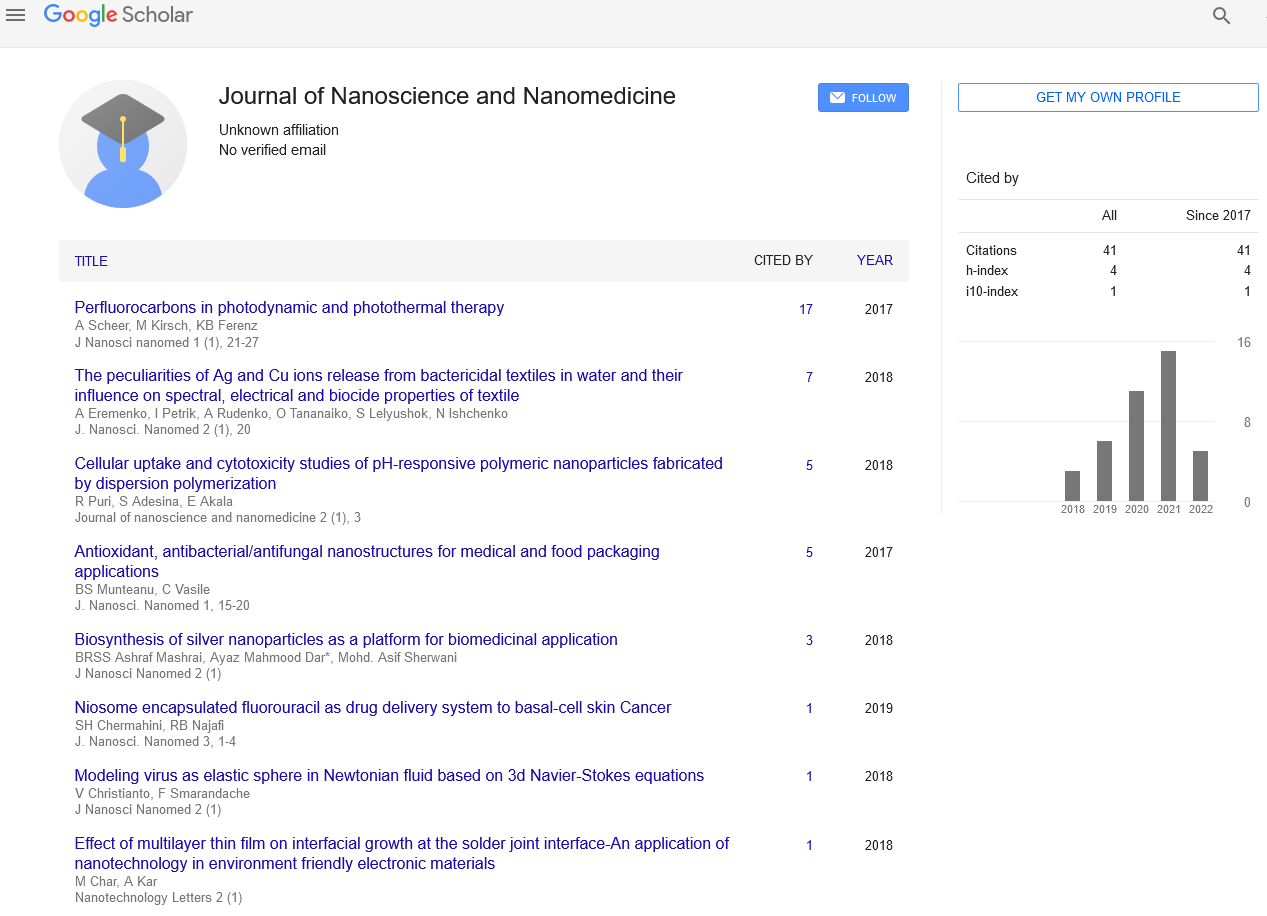Bimetallic Nanoparticles Improve the Optoelectrochemical Properties of Nanoclay
Received: 07-Sep-2022, Manuscript No. PULJNN-22-5814; Editor assigned: 09-Sep-2022, Pre QC No. PULJNN-22-5814 (PQ); Accepted Date: Sep 29, 2022; Reviewed: 18-Sep-2022 QC No. PULJNN-22-5814 (Q); Revised: 27-Sep-2022, Manuscript No. PULJNN-22-5814 (R); Published: 30-Sep-2022, DOI: 10.37532/puljnn.2022.6(5).1-2
Citation: Griffith J. Bimetallic nanoparticles improve the opto-electrochemical properties of nanoclay. J Nanosci Nanomed.2022; 6(5):01-02
This open-access article is distributed under the terms of the Creative Commons Attribution Non-Commercial License (CC BY-NC) (http://creativecommons.org/licenses/by-nc/4.0/), which permits reuse, distribution and reproduction of the article, provided that the original work is properly cited and the reuse is restricted to noncommercial purposes. For commercial reuse, contact reprints@pulsus.com
Abstract
This investigation evaluates the physical and electrochemical modifications of bentonite nanoclay functionalized with bimetallic Ag-Au nanoparticles. In order to develop a better sensing material or film, nanoclay was researched. Bimetallic Ag-Au c nanoparticles were created via a chemical co-reduction technique, and then they were employed to create an Ag-Au/PGV bentonite composite. Using the scanning electron microscope, ultraviolet visible spectroscopy, X-ray diffraction, and Fourier transform infrared, bimetallic Ag-AuNPs and their nanoclay composite were optically characterised. Their electrochemical activity and properties were then determined using Cyclic Voltammetry (CV) and Differential Pulse Voltammetry (DPV). According to surface morphological examination results, which concur with XRD, the average size was 10 nm.
Key Words
Spectroscopy; Montmorillonite; Nanocomposite
Introduction
The most fundamental and prevalent component of bentonite clay, Montmorillonite (MMT), is what is commonly referred to as a bentonite. Smectites, layers of clay that contain a negative charge, are one of its constituents, among others. The species found in the strata include silicates and tetrahedrons, which frequently comprise metals like magnesium, sodium, and iron. When water is added to bentonite, its volume multiplies by many times, resulting in the formation of a gelatinous and viscous fluid. Bentonite is an excellent material for a variety of functions and applications due to its intriguing characteristics, including hydration, swelling, water absorption, viscosity, and thixotropy.
The literature claims that bentonite clay's enormous surface area has improved its cation exchangeability, chemical stability, and catalytic characteristics. In order to identify drugs and harmful metal ions, bentonite has been effectively used as a sensing material and in the construction of electrochemical sensors. More recently, studies on bentonite modification for adsorption applications have been reported. Numerous substances, ranging from organic to inorganic substrates, have been employed as modifiers, and a recent study found that bentonite coated with iron oxide to form a bentonite composite was used to remove contaminants from aqueous medium. However, due to on-transfer capacity, the drawbacks of bentonite-ba bentonite-based electrochemical sensors have relatively low sensitivity.
Due to their high surface area, plasmonic resonance, and strong conductivity, metal NPs have been utilised to functionalize such materials in order to get over the limits of surfaces that in particular have limited electron transfer capacity. Because of their capacity to self-assemble on the support surface, nanoparticles with at least one dimension size of 10nm-100 nm may have a variety of morphologies and be utilised in a wide range of applications.
The combination of priceless metal elements within a tiny crystallite nanoscale is also receiving more interest because of its distinctive properties and potential for significant effects. Bimetallic precious nanoparticles have been demonstrated to improve selectivity, boost stability, or raise catalytic turnover rates in the context of heterogeneous catalysis. Due to their more intriguing features, bimetallic nanoparticles are more interesting from a scientific and technological standpoint than equivalent monometallic ones. Due to their remarkable flexibility and increased characteristics, clay-based nanocomposites have drawn a lot of attention in the pharmaceutical industry and have become important resources.
In the biomedical field, Ag-Au bimetallic NPs are gaining more attention than individual AgNPs and AuNPs due to their antibacterial activity, and in electrochemical studies because of their improved catalytic activity, surface area, and electron transfer.
Many electrochemical sensor platforms with quick, real-time, and straightforward analysis have been suggested as alternatives to traditional methods for straightforward detection systems. Here, we created a bimetallic Ag-AuNP-based electrochemical sensor made of bentonite clay nanocomposite. As far as we are aware, this type of sensor has never been referenced in any studies in the literature. The sensor displayed improved thermal stability, conductivity, catalytic activity, and electrochemical characteristics. Utilizing Cyclic Voltammetry (CV) and Differential Pulse Voltammetry (DPV) techniques, the sensor was characterised in order to determine how the nanocomposite affected the peak current.
SEM was used to illustrate morphological structures, and Fourier Transmittance Infrared Spectroscopy (FTIR) was used to pinpoint the molecular interaction that resulted from the addition of bimetallic nanoparticles to clay. Bimetallic Ag-AuNPs were also studied using UV-VIS, and the nanocomposite's crystal structure, crystallite size, and strain patterns were examined using X-ray Diffraction (XRD).
Create a potential new structural material, Ag-Au/PGV bentonite nanocomposite, suitable for sensing applications. By combining complimentary methods such as SEM, FTIR, UV-VIS, XRD, CV, and DPV, the desired structural and electrochemical properties of PGV bentonite, AgNPs, Ag-AuNPs, and AgAu/PGV bentonite nanocomposite were successfully attained. With an average size of 10 nm, the nanocomposite's particle sizes were smaller than those of pure clay and bimetallic nanoparticles. Strong LSPR bands of 416nm and 519nm are visible in the UVVis analyses of bimetallic Ag-AuNPs, which is a sign of nanoparticle production. Strong proof that clay was included in the bimetallic nanoparticles is provided by the FTIR spectrum and XRD results of the Ag-Au/PGV bentonite nanocomposite. The efficiency of Ag-Au/PGV bentonite with a more significant current response than that of PGV and bimetallic Ag-AuNPs is demonstrated by the electrochemical characteristics of the glassy carbon electrode modified with nanocomposites. The results of this work demonstrated that the surface and electrochemical characteristics of bentonite clay were enhanced by functionalization with Ag-Au NPs, bentonite can be functionalized with metallic NPs as a different approach to increasing its surface electrochemical capacity and its usage as a reliable sensing material for electrochemical sensors.





